Machine learning gene expression predicting model for ustekinumab response in patients with Crohn's disease
- PMID: 34469062
- PMCID: PMC8589399
- DOI: 10.1002/iid3.506
Machine learning gene expression predicting model for ustekinumab response in patients with Crohn's disease
Abstract
Background: Recent studies reported the responses of ustekinumab (UST) for the treatment of Crohn's disease (CD) differ among patients, while the cause was unrevealed. The study aimed to develop a prediction model based on the gene transcription profiling of patients with CD in response to UST.
Methods: The GSE112366 dataset, which contains 86 CD and 26 normal samples, was downloaded for analysis. Differentially expressed genes (DEGs) were identified first. Gene Ontology (GO) and Kyoto Encyclopedia of Genes and Genomes (KEGG) pathway analyses were administered. Least absolute shrinkage and selection operator regression analysis was performed to build a model for UST response prediction.
Results: A total of 122 DEGs were identified. GO and KEGG analyses revealed that immune response pathways are significantly enriched in patients with CD. A multivariate logistic regression equation that comprises four genes (HSD3B1, MUC4, CF1, and CCL11) for UST response prediction was built. The area under the receiver operator characteristic curve for patients in training set and testing set were 0.746 and 0.734, respectively.
Conclusions: This study is the first to build a gene expression prediction model for UST response in patients with CD and provides valuable data sources for further studies.
Keywords: Crohn's disease; LASSO regression; machine learning model; ustekinumab.
© 2021 The Authors. Immunity, Inflammation and Disease published by John Wiley & Sons Ltd.
Conflict of interest statement
The authors declare that there are no conflict of interests.
Figures
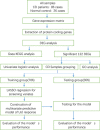
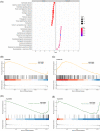
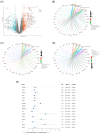
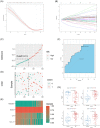
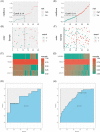
Similar articles
-
Ustekinumab affects myofibroblast metabolism to alleviate intestinal fibrosis by targeting KDELC1 in Crohn's disease through multi-machine learning combined with single-cell sequencing analysis.Front Med (Lausanne). 2024 Oct 22;11:1476592. doi: 10.3389/fmed.2024.1476592. eCollection 2024. Front Med (Lausanne). 2024. PMID: 39502647 Free PMC article.
-
Identifying hub genes in response to ustekinumab and the impact of ustekinumab treatment on fibrosis in Crohn's disease.Front Immunol. 2024 May 22;15:1401733. doi: 10.3389/fimmu.2024.1401733. eCollection 2024. Front Immunol. 2024. PMID: 38840917 Free PMC article.
-
Ustekinumab trough concentration affects clinical and endoscopic outcomes in patients with refractory Crohn's disease: a Chinese real-world study.BMC Gastroenterol. 2021 Oct 18;21(1):380. doi: 10.1186/s12876-021-01946-8. BMC Gastroenterol. 2021. PMID: 34663208 Free PMC article. Clinical Trial.
-
Concomitant use of an immunomodulator with ustekinumab as an induction therapy for Crohn's disease: A systematic review and meta-analysis.J Gastroenterol Hepatol. 2021 Jul;36(7):1744-1753. doi: 10.1111/jgh.15401. Epub 2021 Feb 3. J Gastroenterol Hepatol. 2021. PMID: 33450096
-
Ustekinumab therapy for Crohn's disease during pregnancy: a case report and review of the literature.J Clin Pharm Ther. 2017 Apr;42(2):234-236. doi: 10.1111/jcpt.12492. Epub 2016 Dec 22. J Clin Pharm Ther. 2017. PMID: 28004853 Review.
Cited by
-
Artificial intelligence to revolutionize IBD clinical trials: a comprehensive review.Therap Adv Gastroenterol. 2025 Feb 23;18:17562848251321915. doi: 10.1177/17562848251321915. eCollection 2025. Therap Adv Gastroenterol. 2025. PMID: 39996136 Free PMC article. Review.
-
Impact of artificial intelligence on prognosis, shared decision-making, and precision medicine for patients with inflammatory bowel disease: a perspective and expert opinion.Ann Med. 2023;55(2):2300670. doi: 10.1080/07853890.2023.2300670. Epub 2024 Jan 1. Ann Med. 2023. PMID: 38163336 Free PMC article. Review.
-
Precision medicine and drug optimization in adult inflammatory bowel disease patients.Therap Adv Gastroenterol. 2023 May 10;16:17562848231173331. doi: 10.1177/17562848231173331. eCollection 2023. Therap Adv Gastroenterol. 2023. PMID: 37197397 Free PMC article. Review.
-
Artificial intelligence in inflammatory bowel disease: innovations in diagnosis, monitoring, and personalized care.Therap Adv Gastroenterol. 2025 Jul 23;18:17562848251357407. doi: 10.1177/17562848251357407. eCollection 2025. Therap Adv Gastroenterol. 2025. PMID: 40718706 Free PMC article. Review.
-
Predicting ustekinumab treatment response in Crohn's disease using pre-treatment biopsy images.Bioinformatics. 2025 Jun 2;41(6):btaf301. doi: 10.1093/bioinformatics/btaf301. Bioinformatics. 2025. PMID: 40366737 Free PMC article.
References
-
- Kaplan GG. The global burden of IBD: from 2015 to 2025. Nat Rev Gastroenterol Hepatol. 2015;12(12):720‐727. - PubMed
-
- Feagan BG, Sandborn WJ, Gasink C, et al. Ustekinumab as induction and maintenance therapy for Crohn's disease. N Engl J Med. 2016;375(20):1946‐1960. - PubMed
-
- Geremia A, Satsangi J. The role of genetics in Crohn's disease: how could it influence future therapies? Expert Rev Gastroenterol Hepatol. 2018;12(11):1075‐1077. - PubMed
Publication types
MeSH terms
Substances
LinkOut - more resources
Full Text Sources
Medical

